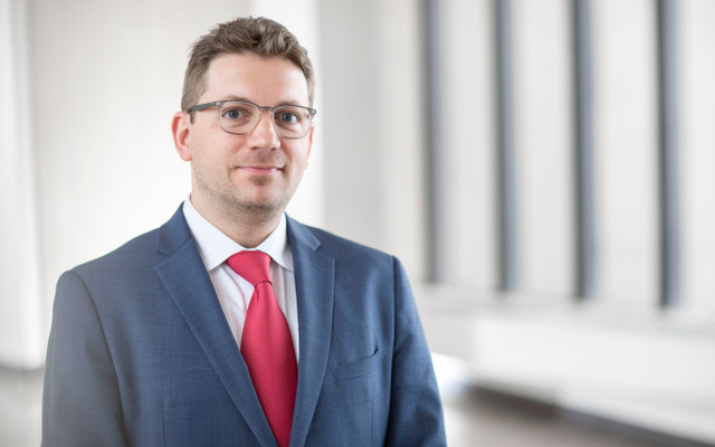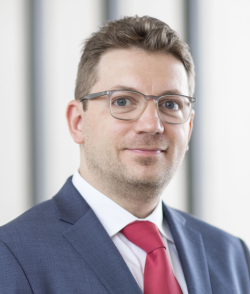Faculty Spotlight: Bioengineering Research Around the Globe

Umut Gurkan is one to stay busy.
In addition to being the Warren E. Rupp Associate Professor in the Mechanical and Aerospace Engineering Department, he holds a secondary appointment in the Department of Biomedical Engineering at Case Western Reserve University.
He also leads the university’s Biomanufacturing and Microfabrication Laboratory, while still teaching coursework in its online master’s of biomedical engineering program.
His research has taken him to Ghana, Nigeria, India and Thailand, and has led to more than 80 peer-review papers as well as 9 issued U.S. patents and numerous international patents. He was elected a senior member of the National Academy of Inventors in 2020.
In this interview, he discusses his research in micro technologies, the real challenges of international research and what many engineers forget: the human factor.
What first drew you here to Case Western Reserve?
Cleveland is a healthcare city. There are so many hospitals here: Cleveland Clinic, University Hospitals, Cleveland VA medical center and the MetroHealth System and the university’s hospitals. Healthcare, medicine and biomedicine are among the primary drivers of the professional and the socioeconomic reality here in Cleveland. Being at a place like Case Western Reserve University helps us work with the patients, the physicians, physician-scientists, caregivers and nurses who work with these types of diseases on a day-to-day basis.
Our research is highly translational, meaning that it's right at the interface between the innovations that happen in the research labs and healthcare delivery where those innovations are put into practice. Our research is quite translational in this regard.
That's interesting. I didn’t realize that you would also consider outside institutions and clinics, in addition to the Case School of Engineering itself.
Exactly. This actually brings me to the course that I'm teaching here, Micro Electro Mechanical Systems and Biomanufacturing. It's the application of micro/nano technologies to medicine. How do we take what we learned from the micro/nano fabrication industry that made the computer age and information age possible? How do we apply what we learn in that area to medicine?
That's essentially what our research is focused on. We use similar types of fabrication methods that are used to make computer chips, like the Intel chips or the new Apple chip. The type of materials that they use would allow you to bring to life these fine designs, the small scale features that make the transistors possible. Can we use those fabrication methods to create technologies or systems that would help solve some problems in medicine? This becomes especially important if you want to be at the scale of our DNA, proteins or cells.
Virus, bacteria, they go and interact with the cells. We want to understand how they interact with cells so that we can develop some kind of a treatment. When you want to research those things, when you want to understand those interactions, you need tools that would allow you to go down to the scale of the virus or cells. The concepts that I teach in this EMAE 456 course are exactly those. How do we engineer systems that would allow us to go down to the scales of virus, the bacteria, the proteins or the cells?
What drove you to pursue this field, because it sounds like a type of research that requires a lot of collaboration?
The type and the diversity of the collaborations that we have in our research projects is key. Most of the projects we work on are highly multidisciplinary and interdisciplinary, not only from different fields of science, engineering or medicine. To come up with the best, realistically feasible solution, we also need to work with people from different backgrounds or different ethnicities and with people who live in different parts of the world. We want to develop a technology that people would like to use or that people would understand, and this all depends on the history of the patient or the doctor and where this technology would be used. I think that's what I like the most about our research, it’s interdisciplinary and multidisciplinary in many regards, and not just technically but also socially and culturally.
Is there an example of a project you've done where maybe you were surprised or your plans had to change because of feedback you got from someone else?
We recently developed a diagnostic technology for sickle cell disease. It's a genetic disease that people are born with. You might just be a carrier or you might have the disease. The technology we develop helps diagnose this disease in a simple blood test, in a drop of blood that you get from a finger prick or a heel prick of a baby. This makes the diagnosis of this disease much more accessible, available and affordable.
We always considered that the best time to test for this disease would be immediately after birth. When a baby is born, you can get the results even before the family leaves the hospital. Our experience in Africa, after lots of interviews, talking with nurses, talking with parents, talking with the caregivers in the maternity wards and the hospitals, we realized that not everybody may want to learn the results of the test immediately after birth. They may want to get the test done, but they may not want to get the results immediately or right away. We realized that roughly half of the people say, "I don't need to hear the results of the tests. I just had a baby, just let me go home and relax. I will deal with this later, whatever it is."
This observation made us think about alternatives: One thing that we realized is many babies come for their first vaccination around four to six weeks after they are born. At that time, especially in Africa or India, the parents are also provided with some basic training on taking care of the baby. Many people, including parents and nurses, thought that having a genetic diagnostic test at the time of first immunization is much more reasonable. It's now a few weeks after the baby is born, and for many, some of these genetic diseases don't really impact the patient's health in the first few months.
Anyway, we realized that people prefer to get tested at the time of immunization, when there is a nurse or a counselor present who can tell them what the result means. What does it mean for the baby? What does it mean for the parents? What they need to do next? This was the social or maybe more personable aspect of our research. That taught us that having a technology that gives you information or that measures something that wasn't available before is not always good.
So timing and context really are key?
Exactly. If you think about the practice here (in the United States), they collect blood samples, they send them to a state lab and the results are sent to the pediatrician, not to the parents. If there's something wrong, then the pediatrician contacts the parents after a few weeks, and then, in a proper setting, they tell them what the disease is or what they need to do.
As an engineer, you always think that, "I want to make it accessible, I want to make it possible." You don't always think that not everybody wants that. It's good in the right context, at the right time, when the right people are present.
What are some of the challenges that you face when you're working across multiple countries?
We face technical challenges, resource-related challenges, infrastructure-related challenges. Those are the most obvious things though: power outages, the dust and the dirt, and the humidity. I'm not going to talk about them. Those are a given, and those are now the type of things that we deal with on a routine basis.
But again, I think the social and cultural differences are the main things that are typically underestimated or not considered. We will develop something here, you take it to India and you think that people will be amazed by this new invention or discovery. They will be all over it and they will start using it immediately. It's not always the case. You might face a totally different situation because of the cultural and social stigma or their history with technology. They might associate your technology with something evil in certain cases. You never know what you will come across.
The key is to keep an open mind about these things. Do your research. Before we go to a clinical site for testing of a new technology, we make sure that we do our homework before we go there. We make sure that we talk to someone from that region, someone who understands what we are doing, and they can help us design the study properly at the right place and at the right time. Sometimes the timing is not good. Think about the elections that we just had here: If you go try to do something just before an election in a certain region or a country, it might not be the right time.
What drives you to keep working in this space and in international studies?
Every project and every new test that we work on, it's almost like a new adventure. You meet with new people, you go to a new place, you learn new things, you interact with different types of individuals, patients, parents and children. It's almost like each project becomes an expedition. You really don't know what you are going to get. The key is talking to as many people as you can from different backgrounds, from different disciplines, from different ages, different ethnicities. The more people you talk with, the better solutions you develop for these emerging or pressing problems. It's almost like going to a new place, like let's say you are going to a new country for a trip or for a vacation, right? You feel excited about it because you have certain anticipations, but at the end of the day, you don't know what you are going to see when you get there.
I can see that. I don't know if I naturally associate bioengineering research with such open-ended questions?
I think it's because of the social aspect of it. What will people think about this new device or what people will think about this new technology? How will they use it? How will this change their behavior after they use it? How will this change the way they treat the patient or the way they manage this disease? It's not the technology or the device that we look for, it's those social interactions and the people's response to the technology, to the invention or the discovery. I think that's the excitement.
People think that they have a very good solution to a problem, and they think like this until they try to put it into use. Many of those inventions, many of those discoveries, they are smartly done, they are exceptionally sophisticated and complex, and they might be solving a real problem. However, if the human factor is not one of your design considerations, or how people will interact with it and use it, then whatever you invent may not be successful.
Innovation lives at CWRU.
Case Western Reserve faculty are researchers and experts in engineering leadership, biomedical engineering, mechanical engineering and systems and control engineering. Learn more about our commitment to excellence and innovation through global partnerships.

